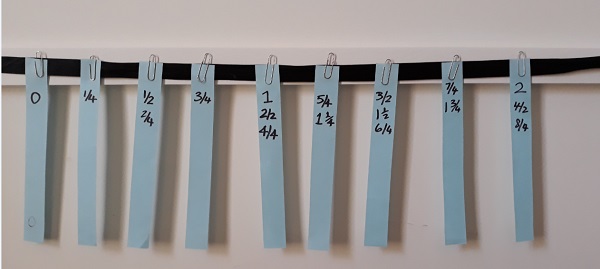An example of this strategy in a Year 7 class would be to engage students in the construction of a string number line (VCMNA242,
VCMNA247).
Scenario
Provide students with a length of string, strips of paper and clips (for attaching the paper strips to the string).
Developing a number line
Ask students to write numbers on the paper strips and to decide where to attach to the string, starting with 0, 1 and 2.
Note that strips of paper are used as they hang down underneath the string and multiple symbols can be written down the one strip to show different ways of writing the same number (i.e., they are located at the same point on the number line).
Ask students to show where
1⁄2,
2⁄2,
3⁄2,
4⁄2 would be on the number line:
1/2 needs a new strip
2/2 would be written on the same strip as 1
3/2 needs a new strip and could also be written as 11/2
4/2 would be written on the same strip as 2
Repeat for other fractions, this time for quarters up to 2 (i.e.
1⁄4,
2⁄4 …
8⁄4)
Continue until students have noted various fractions on the one strip (so same place on number line):
Proper fraction example:
1/2,
2/4,
4/8, etc. (“equivalent fractions, fraction family”)
Improper fractions & mixed number examples: 11/2,
3/2,
6/4, 12/4
 Number line from the exercise
Number line from the exercise
Extending the activity
This activity can be extended to include percentages and decimals:
1/2, 50%, 0.5, 0.50, 0.500 are on the same strip (so same place on number line)
3/2, 11/2, 150%, 1.5, 1.50, 1.500
This activity can also be extended to include negative integers and negative rational numbers:
-1/2,
-2/4,
-3/6, -0.5, -0.50, -0.500
-3/2, –11/2, -1.5, -1.50, -1.500
Discussing fraction simplification
Discuss with students that "simplifying" a fraction (such as 4⁄8) means identifying the equivalent fraction that uses the smallest denominator, usually the first number they wrote on the paper strip (here 1⁄2).
Solution
Ask students, "Which is bigger:
3⁄6 or
4⁄8?"
The correct answer is "they are the same" but some students say
4⁄8 as they are distracted by the larger numerator and larger denominator.